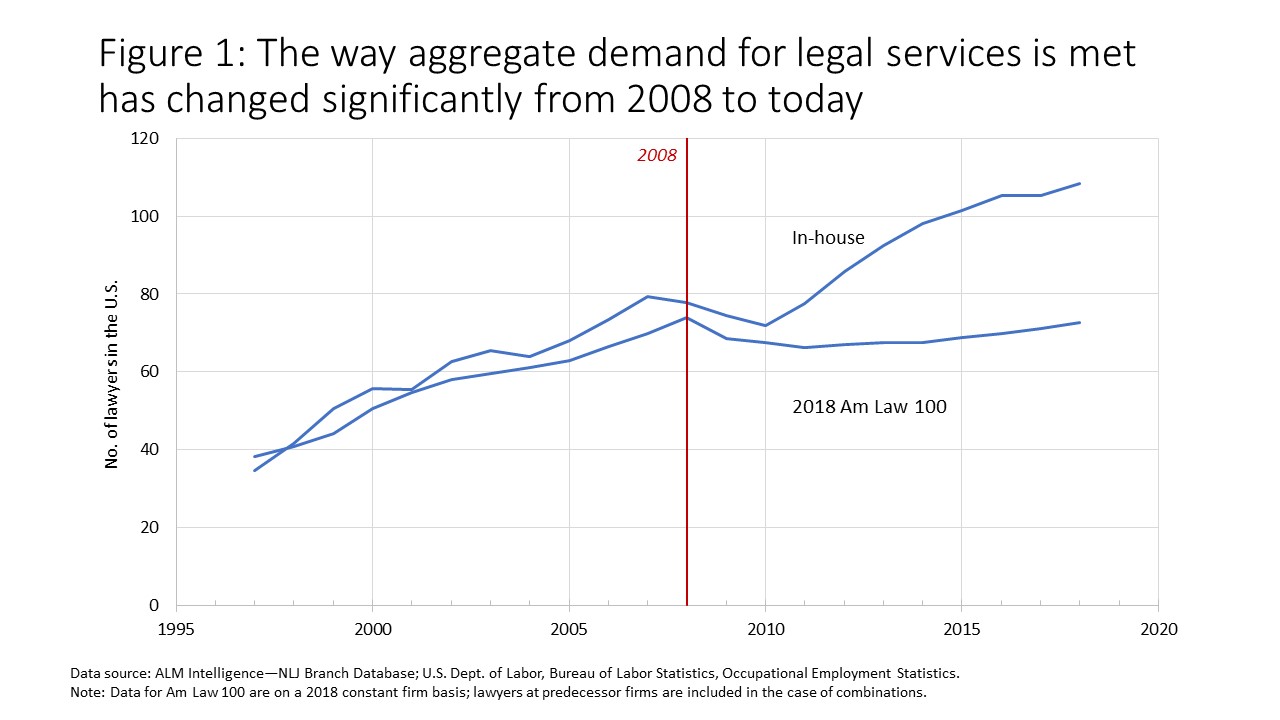The Coronavirus, This Recession and How Law Firms Need to Plan Now to Protect Their Business
Hugh Simons offers practical tips on what law firms can do now to prepare for the impacts of a recession and the coronavirus on their businesses, including potential associate deferrals, hiring slowdowns and marketing investments.
March 13, 2020 at 12:57 PM
6 minute read
The original version of this story was published on The American Lawyer

It's helpful in times like these for leadership teams to have a common understanding of what's going on in the broader economy, its implications for law firm demand and a road map for how to tackle the difficult decisions ahead. The following offers such a framing.
Let's start with the economy. We've entered a recession. We can think of it as ultimately having one of three shapes:
- V-shaped: workers stay home causing a dip in economic output; the dip is followed relatively quickly by a recovery in which workers put in overtime to make up for lost productivity; the economy regains its pre-dip trajectory in a matter of weeks.
- U-shaped: the above initial dip in economic output is accompanied by a decline in consumer demand reflecting, among other issues, a contraction in household wealth (home values, retirement assets, etc.); the policy makers take responsive fiscal and monetary measures and economic activity returns to pre-dip growth rate in a matter of months.
- L-shaped: the recession starts out as U-shaped, but the policy interventions prove ineffective and the dip is prolonged into quarters and years.
We experienced a V-shaped dip and recovery with SARS in 2002-03. However, SARS and COVID-19 are very different. When SARS had run its course, there had been a total of 668 cases and 89 deaths outside of China; with COVID-19, the comparable numbers are already over 45,000 and 1,500. Thus, a V-shaped recovery is a best-case scenario.
A U-shaped recession would be similar to that following the 2008 global financial crisis. The U.S. government increased its debt from 65% to 80% of GDP, and the Fed Funds rate was cut from 5% to effectively zero. The recession officially lasted 18 months, December 2007 to June 2009.
An L-shaped recession, as worse than the global financial crisis, may seem a needlessly bleak scenario to consider. It belongs on the set of possibilities because of the differences between 2008 and today in the starting points for any policy actions. U.S. government debt is currently at 105% of GDP (Q3, 2019), as compared with 65% in 2008, making increasing government borrowing more problematic. Similarly, on March 15, the Fed cut its headline rate to 0.25%, leaving no room for further cuts.
Whatever the shape of the broader economic recession, the effect on law firm demand will be an exaggerated response to it. This was the case in 2008 but it will be even more so this time. This is because of the change since then in how aggregate demand for legal services is met between in-house counsel and outside firms.
Going into the last recession, there were roughly equal numbers of lawyers in the United States who worked in-house and at Am Law 100 law firms. Since then the number of in-house lawyers has grown 40% while that of the Am Law 100 is essentially at the 2008 level, see Figure 1. As the economic recession reduces aggregate demand for legal services, we can expect in-house lawyers to focus first on keeping themselves busy, passing to outside counsel only that work which they truly cannot handle in-house. Parenthetically, we can also expect that, for the work they do send outside, they'll look for considerable price relief.

Law firm leaders don't need to take a stance on the ultimate shape of this recession. They can let it reveal itself over time. However, they need to do three things now. Firstly, support clients in their immediate difficulties—e.g. form a task force to ensure all major clients are being contacted by senior firm representatives and offered help in any way possible, both professional and personal, to navigate the short-term exigencies.
Secondly, they need to be ready with targeted initiatives to stoke demand. One example: set aside a virtual budget for key client investment initiatives and have time charged to this budget carry the same internal standing as full-priced client work; another example: reset the parameters deemed acceptable by the pricing committee in order to win major matters.
Thirdly, there are set of capacity and cost issues to address now so as to be able to act quickly and decisively as events unfold. Examples of these include:
- Equity partner transitions: the frothy market of the last several years has kept occupied many partners who will not be able to keep themselves adequately busy at the right price point in a U- or L-shaped recession. Laterals probably warrant particular attention.
- Income partner transitions: the income partner ranks at some firms became a holding ground for executing lawyers who can be valuably employed when business is robust but for whom there isn't a long-term business case as a partner and who may be blocking the advancement prospects of others.
- Overhead cost management: firms should review their cost structures, distinguishing between those line items that are 'demand' side (e.g. marketing, business development) and 'supply' side (e.g. recruiting events). The former should be retained or increased; the latter should be reduced or deferred (e.g. IT systems upgrades). Indeed, firms may want to freeze immediately all supply-side admin hiring.
- Terminate flailing growth initiatives: the market exuberance of recent years has facilitated a wait-and-see attitude on certain investments for which there truly isn't a reason to wait.
- Deferral of incoming associate class: determine now when the decision will be made and, if deferred, what alternatives would be offered, e.g. firm-subsidized furloughs at pro bono organizations?
- Curtail the length of the summer program: again, determine now when the decision will be made.
The coming months portend to be very difficult on numerous fronts. It falls on firm leaders to engage now in the difficult but necessary work that will enable them steer their organizations to safer seas. Delay merely limits options.
Hugh A. Simons is formerly a senior partner and executive committee member at The Boston Consulting Group and chief operating officer and policy committee member at Ropes & Gray. He welcomes reader reactions at [email protected].
NOT FOR REPRINT
© 2025 ALM Global, LLC, All Rights Reserved. Request academic re-use from www.copyright.com. All other uses, submit a request to [email protected]. For more information visit Asset & Logo Licensing.
You Might Like
View All

Nevada Supreme Court Rejects Uber-Backed Ballot Initiative for 20% Fee Cap
4 minute read

Starbucks Hands New CLO Hefty Raise, Says He Fosters 'Environment of Courage and Joy'
Trending Stories
- 1Is It Time for Large UK Law Firms to Begin Taking Private Equity Investment?
- 2Federal Judge Pauses Trump Funding Freeze as Democratic AGs Launch Defensive Measure
- 3Class Action Litigator Tapped to Lead Shook, Hardy & Bacon's Houston Office
- 4Arizona Supreme Court Presses Pause on KPMG's Bid to Deliver Legal Services
- 5Bill Would Consolidate Antitrust Enforcement Under DOJ
Who Got The Work
J. Brugh Lower of Gibbons has entered an appearance for industrial equipment supplier Devco Corporation in a pending trademark infringement lawsuit. The suit, accusing the defendant of selling knock-off Graco products, was filed Dec. 18 in New Jersey District Court by Rivkin Radler on behalf of Graco Inc. and Graco Minnesota. The case, assigned to U.S. District Judge Zahid N. Quraishi, is 3:24-cv-11294, Graco Inc. et al v. Devco Corporation.
Who Got The Work
Rebecca Maller-Stein and Kent A. Yalowitz of Arnold & Porter Kaye Scholer have entered their appearances for Hanaco Venture Capital and its executives, Lior Prosor and David Frankel, in a pending securities lawsuit. The action, filed on Dec. 24 in New York Southern District Court by Zell, Aron & Co. on behalf of Goldeneye Advisors, accuses the defendants of negligently and fraudulently managing the plaintiff's $1 million investment. The case, assigned to U.S. District Judge Vernon S. Broderick, is 1:24-cv-09918, Goldeneye Advisors, LLC v. Hanaco Venture Capital, Ltd. et al.
Who Got The Work
Attorneys from A&O Shearman has stepped in as defense counsel for Toronto-Dominion Bank and other defendants in a pending securities class action. The suit, filed Dec. 11 in New York Southern District Court by Bleichmar Fonti & Auld, accuses the defendants of concealing the bank's 'pervasive' deficiencies in regards to its compliance with the Bank Secrecy Act and the quality of its anti-money laundering controls. The case, assigned to U.S. District Judge Arun Subramanian, is 1:24-cv-09445, Gonzalez v. The Toronto-Dominion Bank et al.
Who Got The Work
Crown Castle International, a Pennsylvania company providing shared communications infrastructure, has turned to Luke D. Wolf of Gordon Rees Scully Mansukhani to fend off a pending breach-of-contract lawsuit. The court action, filed Nov. 25 in Michigan Eastern District Court by Hooper Hathaway PC on behalf of The Town Residences LLC, accuses Crown Castle of failing to transfer approximately $30,000 in utility payments from T-Mobile in breach of a roof-top lease and assignment agreement. The case, assigned to U.S. District Judge Susan K. Declercq, is 2:24-cv-13131, The Town Residences LLC v. T-Mobile US, Inc. et al.
Who Got The Work
Wilfred P. Coronato and Daniel M. Schwartz of McCarter & English have stepped in as defense counsel to Electrolux Home Products Inc. in a pending product liability lawsuit. The court action, filed Nov. 26 in New York Eastern District Court by Poulos Lopiccolo PC and Nagel Rice LLP on behalf of David Stern, alleges that the defendant's refrigerators’ drawers and shelving repeatedly break and fall apart within months after purchase. The case, assigned to U.S. District Judge Joan M. Azrack, is 2:24-cv-08204, Stern v. Electrolux Home Products, Inc.
Featured Firms
Law Offices of Gary Martin Hays & Associates, P.C.
(470) 294-1674
Law Offices of Mark E. Salomone
(857) 444-6468
Smith & Hassler
(713) 739-1250






